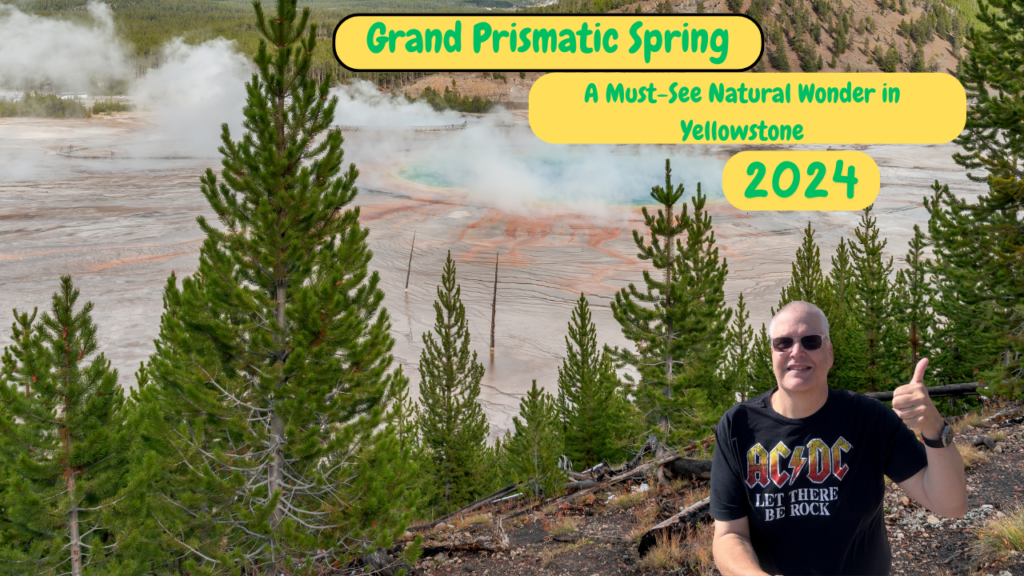Grand Prismatic Spring
Nestled within Yellowstone National Park’s Midway Geyser Basin, the Grand Prismatic Spring captivates visitors with its stunning rainbow-colored waters. This natural wonder stretches 370 feet in diameter and plunges 121 feet deep, making it the largest hot spring in the United States and the third-largest in the world.
The spring’s mesmerizing colors come from different types of heat-loving bacteria that thrive in its mineral-rich waters. These bacteria create rings of orange, yellow, green, and blue that surround its deep blue center.
National Park Pass for Seniors Review

Visitors can view this extraordinary thermal feature from two perspectives. The accessible boardwalk path winds through the Midway Geyser Basin, offering close-up views of the steaming spring.
For those seeking the iconic overhead perspective, the Grand Prismatic Overlook provides spectacular views via a short 1.2-mile round-trip hike from the Fairy Falls parking lot.
The Grand Prismatic Spring has become one of the most photographed natural features in Yellowstone. Its vibrant colors shift with seasonal changes and lighting conditions, creating a dynamic display that never looks exactly the same twice. The combination of its massive size and rainbow palette makes it an unforgettable highlight of any Yellowstone visit.
Key Takeaways
- Grand Prismatic Spring is the largest hot spring in the United States, measuring 370 feet in diameter and 121 feet deep.
- The spring’s rainbow colors come from different types of bacteria that live in its mineral-rich waters at various temperatures.
- Visitors can experience this natural wonder from the boardwalk path or get an overhead view from the Grand Prismatic Overlook trail.
Geological Marvel
The Grand Prismatic Spring stands as an extraordinary geological feature in Yellowstone National Park, combining vibrant colors with impressive size. This natural wonder demonstrates the powerful forces at work beneath the Earth’s surface.
Formation of Grand Prismatic Spring
The Grand Prismatic Spring formed through continuous geothermal activity in the Midway Geyser Basin of Yellowstone National Park, Wyoming. It is the largest hot spring in the United States and the third-largest in the world.
The spring sits atop a crack in the Earth’s surface where hot water rises from an underground reservoir. The water temperature reaches approximately 160°F (70°C) in the center of the pool.
What makes this hot spring truly remarkable is its rainbow of colors. The blue center results from the water’s purity and depth. The outer rings display orange, yellow, and green hues created by heat-loving bacteria called thermophiles.
These microorganisms form different colored mats depending on the water temperature. The cooler edges allow different species to thrive, creating the spring’s signature prismatic effect.
The Grand Prismatic Spring measures approximately 370 feet (113 meters) in diameter and over 121 feet (37 meters) deep. The spring discharges an estimated 560 gallons of water per minute.
Mineral-rich water continuously flows from the spring, depositing sinter terraces that gradually build up around its edges. This ongoing process has shaped the spring’s distinctive appearance over thousands of years.
Spectacle of Colors
The Grand Prismatic Spring displays an amazing rainbow of colors from deep blue in the center to orange and red at the edges. These vivid hues result from a combination of microorganisms and water temperature variations.
Microbial Mats

Different types of bacteria create the brilliant colors seen around the Grand Prismatic Spring.
In the cooler outer edges, orange and red colors come from bacteria called thermophiles that thrive in temperatures between 120-140°F. These bacteria produce carotenoid pigments similar to those found in carrots.
Yellow areas contain slightly different bacterial communities that prefer temperatures around 140-160°F. The green zones host yet another group of heat-loving microbes.
Each bacterial community forms thick, layered mats around the spring’s edges. These mats can be up to several inches thick and create a living carpet of color that changes with the seasons and temperature fluctuations.
Scientists study these unique bacteria because they can survive in conditions that would kill most other organisms on Earth.
Environmental Factors
The mesmerizing blue center of Grand Prismatic Spring comes not from bacteria but from the water itself. This deep blue color results from light scattering in the clear, mineral-rich water that reaches temperatures of about 189°F—too hot for most microbes to survive.
Water temperature plays a crucial role in the color display.
As hot water flows outward from the center, it gradually cools, creating distinct temperature zones where different bacteria can grow.
Sunlight affects the colors significantly. The vibrant hues appear most intense on sunny days when bacteria produce more pigments to protect themselves from UV radiation.
Seasonal changes also influence the spring’s appearance. During summer, bacterial mats grow thicker and colors become more vibrant. Winter brings paler colors as some bacteria become less active in cooler air temperatures.
Exploring Midway Geyser Basin
Midway Geyser Basin houses some of Yellowstone’s most spectacular thermal features, including the famous Grand Prismatic Spring. This relatively small basin packs incredible natural wonders into a compact, accessible area.
Points of Interest
The star attraction of Midway Geyser Basin is undoubtedly Grand Prismatic Spring, Yellowstone’s largest hot spring. At 370 feet in diameter and over 121 feet deep, it ranks as the third-largest hot spring in the world. The spring’s rainbow-like colors result from different types of heat-loving bacteria (thermophiles) that thrive in its mineral-rich waters.
Excelsior Geyser Crater is another remarkable feature. Once an active geyser that erupted up to 300 feet high, it now functions as a hot spring that discharges approximately 4,000 gallons of boiling water per minute into the Firehole River.
Turquoise Pool and Opal Pool offer additional stunning views with their clear blue waters and distinctive coloration. These smaller thermal features complement the larger attractions and are worth observing during your visit.
Visitor Facilities
Midway Geyser Basin features a well-maintained boardwalk system that provides safe viewing of all major thermal features. The elevated wooden paths protect both visitors and the delicate thermal ecosystem.
The parking area at Midway Geyser Basin can become crowded, especially during summer months between 10 AM and 4 PM. Consider visiting early morning or evening for a more peaceful experience.
Restroom facilities are available at the parking area, but no food services exist within this section of the park. Visitors should bring water, especially during summer visits, as the area offers limited shade.
An accessible route is available for visitors with mobility concerns, though some sections of the boardwalk include moderate inclines. Interpretive signs along the path provide educational information about the thermal features and their scientific significance.
Conservation Efforts
Preserving Grand Prismatic Spring requires careful management to balance visitor access with environmental protection. The National Park Service implements strict measures to safeguard this natural wonder for future generations.
Protecting the Hot Spring Ecosystem
Yellowstone National Park staff closely monitor the delicate microbial communities that give Grand Prismatic Spring its remarkable colors. These microorganisms are extremely sensitive to environmental changes and human interference.
Park authorities regularly test water quality and temperature to track any concerning shifts in the spring’s ecosystem. The surrounding boardwalks are strategically positioned to prevent soil erosion and minimize human impact on the thermal features.
Conservation teams also work to prevent the introduction of foreign substances that could disrupt the spring’s natural chemistry. This includes limiting development near the spring to protect groundwater sources that feed the hydrothermal system.
Regulations and Visitor Impact
Strict visitor guidelines help preserve Grand Prismatic Spring’s pristine condition. Yellowstone National Park prohibits throwing objects into the hot spring or walking off designated paths.
The new elevated overlook trail, completed in recent years, provides spectacular views while reducing environmental pressure on the spring’s immediate surroundings. This 0.6-mile trail rises 105 feet above the valley floor, allowing visitors to appreciate the spring’s vibrant colors without damaging fragile ground.
Park rangers actively educate visitors about proper behavior through informational signs and regular patrols. They enforce regulations against drone usage, which can disturb wildlife and other visitors while potentially contaminating the spring.
Swimming or wading in the spring is strictly forbidden due to both safety concerns and conservation needs.
Photography and Representation
The Grand Prismatic Spring has become one of the most photographed natural features in Yellowstone National Park due to its vibrant colors and striking patterns. Photographers face unique challenges when attempting to capture its true essence, while the spring’s distinctive appearance has made it valuable for various media uses.
Capturing the Essence
Photographing the Grand Prismatic Spring requires careful planning and technique.
Aerial shots, like those featured in National Geographic, showcase the complete circular formation and rainbow of colors most effectively. These views reveal the full color spectrum—from deep blue at the center to orange and red at the edges.
Ground-level photography presents different challenges. Photographers must contend with steam rising from the hot spring, which can obscure views depending on weather conditions. Morning and evening light often provide the best conditions for capturing the vibrant hues created by the heat-loving bacteria.
Professional photographers recommend using polarizing filters to reduce glare on the water surface.
High-resolution cameras capable of capturing images at 300dpi are essential for detailed stock images that showcase the spring’s intricate patterns.
Use in Media and Marketing
The Grand Prismatic Spring appears frequently in media promoting Yellowstone and American natural wonders. Its distinctive colors make it instantly recognizable in:
- Tourism materials for Wyoming and Yellowstone National Park
- Nature documentaries about geothermal features
- Science textbooks illustrating extremophile environments
- Fine art photography collections
Stock image libraries offer numerous vectors and videos of the spring, frequently tagged with keywords like “natural wonder,” “geothermal,” and “bacterial mats.”
Marketing professionals often use these images to represent concepts of diversity, natural beauty, and environmental uniqueness.
The spring’s vibrant appearance makes it particularly valuable for digital media where colorful, eye-catching stock images can increase engagement. Travel companies frequently feature it in advertisements to attract visitors to Yellowstone National Park.
Scientific Research and Studies
The Grand Prismatic Spring serves as a natural laboratory for scientists studying extremophile life forms and unique geological processes. Researchers are particularly interested in the microorganisms that thrive in this harsh environment and what they can teach us about life’s adaptability.
Microbial Research
Scientists from NASA and various universities regularly study the Grand Prismatic Spring. They believe it may provide insights into how life first evolved on Earth. The spring’s extreme conditions mirror what early Earth environments might have been like billions of years ago.
These studies help researchers understand how life might exist on other planets with harsh conditions.
The spring’s colorful rings are living microbial mats that form distinct communities based on temperature gradients. Each ring represents different microorganism species adapting to specific temperature ranges as the water cools with distance from the center.
Research in this area has practical applications too. Some microbes discovered in Yellowstone’s hot springs have led to biotechnology breakthroughs. For example, they include heat-resistant enzymes used in DNA research.
Thermophilic Bacteria
Thermophilic (heat-loving) bacteria thrive in the Grand Prismatic Spring despite temperatures that would kill most organisms. These bacteria have evolved specialized proteins and cell membranes that remain stable at temperatures between 147°F and 188°F (64°C-87°C).
The vibrant colors of the spring come from these bacteria. The orange, red, and brown hues are created by organisms rich in carotenoid pigments. These pigments protect the bacteria from intense sunlight while also conducting photosynthesis.
Thermus aquaticus, discovered in Yellowstone National Park’s hot springs, produces an enzyme called Taq polymerase. This enzyme revolutionized molecular biology by enabling PCR (polymerase chain reaction), a technique fundamental to DNA research, medical diagnostics, and forensic science.
Scientists continue to discover new thermophilic species in the spring each year, suggesting this ecosystem still has many secrets to reveal about life’s resilience.
Practical Information for Visitors
Planning your visit to the Grand Prismatic Spring requires knowing when to go and how to stay safe. This iconic feature in Yellowstone National Park attracts many visitors due to its stunning colors and massive size.
Best Times to Visit
The Grand Prismatic Spring is most vibrant during midday when sunlight enhances its rainbow colors. However, parking is extremely limited, especially between 10 AM and 6 PM when the area is most crowded.
Early morning (before 9 AM) or early evening visits offer fewer crowds and better parking options. The spring is also more photogenic during summer months when temperatures are warmer, creating more steam and vivid colors.
Weekdays typically have fewer visitors than weekends. If visiting during peak season (June-August), prepare for potential lines at the parking area. The boardwalk around the spring can become congested during these busy times.
Accessibility and Safety Tips
The Grand Prismatic Spring can be viewed from two locations: the boardwalk in Midway Geyser Basin or the Grand Prismatic Overlook trail. The overlook trail is 1.2 miles round trip with a 105-foot elevation gain, offering spectacular aerial views.
Stay on designated boardwalks and trails at all times. The ground surrounding thermal features is fragile and dangerous, with scalding water just beneath the surface.
Wear comfortable walking shoes and bring:
- Water bottles
- Sun protection (hat, sunscreen)
- Camera
- Light jacket (even in summer, temperatures can vary)
The boardwalk route is wheelchair accessible, while the overlook trail is moderately challenging. Visit the spring on clear days when steam won’t obscure its brilliant blue center and colorful rings.
Digital Presence
Grand Prismatic Spring has become a visual icon across digital platforms, with spectacular aerial and ground-level images available through various stock photo services. These images capture its vibrant colors and natural beauty for both personal and commercial use.
Stock Photo Availability
Grand Prismatic Spring photos are widely available on major stock image platforms like iStock. These collections feature diverse perspectives including stunning aerial views that showcase the spring’s complete color spectrum. Helicopter shots, like those taken by photographer Gerald Macua, offer unique vantage points that ground-level visitors cannot access.
Professional photographers frequently capture the spring during optimal lighting conditions, resulting in high-quality options for websites, publications, and marketing materials. Many images feature the spring’s striking blue center contrasting with the orange, yellow and green microbial mats surrounding it.
Both royalty-free and rights-managed options exist depending on usage needs. Prices vary based on resolution, exclusivity rights, and intended application.
Image Details and Licensing
Stock photos of Grand Prismatic Spring typically come in multiple resolution options, from web-optimized sizes to large-format prints suitable for commercial displays. High-resolution files often exceed 20MB with dimensions of 5000×3000 pixels or larger.
Most platforms offer compressed download options to reduce transfer times while maintaining acceptable quality for digital use. Standard licensing typically permits editorial and some commercial applications, though specific usage rights vary by provider.
Extended licenses are available for special applications like merchandise, large-format displays, or unlimited distribution. Many images include metadata specifying location details and seasonal information to help users select contextually appropriate visuals.
Attribution requirements differ between platforms, with some requiring photographer credit while others offer completely royalty-free options.
Frequently Asked Questions

Visitors to Grand Prismatic Spring often have similar questions about this natural wonder. Here are answers to the most common inquiries to help you plan a successful visit to this remarkable thermal feature.
What are the hiking trails to reach the Grand Prismatic Spring?
There are two main ways to experience Grand Prismatic Spring. The first is the boardwalk trail through Midway Geyser Basin that takes you right alongside the spring. This flat, accessible path is approximately 0.8 miles round trip.
The second option is the Grand Prismatic Spring Overlook Trail. This trail begins from the Fairy Falls parking area and is about 1.2 miles round trip with moderate elevation gain. The overlook provides a stunning aerial view of the entire spring.
What is the significance of the Grand Prismatic Spring in Yellowstone?
Grand Prismatic Spring is the largest hot spring in the United States and the third largest in the world. It measures approximately 370 feet in diameter and reaches 121 feet in depth.
The spring serves as a symbol of Yellowstone’s unique geothermal features. Scientists study it to understand extremophile organisms that thrive in harsh conditions. These microorganisms have applications in medicine, genetics, and other scientific fields.
How can one safely navigate around the Grand Prismatic Spring?
Stay on designated boardwalks at all times. The ground surrounding thermal features is fragile and may collapse under weight, potentially causing severe burns.
Never touch the water as temperatures range from 160°F to 190°F (70°C to 88°C). Keep children close and pets on leashes. Throwing objects into springs is prohibited as it damages these delicate ecosystems.
Wear appropriate footwear with good traction, especially on misty days when boardwalks may be slippery. Follow all posted signs and ranger instructions.
What causes the vibrant colors of the Grand Prismatic Spring?
The spectacular rainbow colors come from different types of thermophilic (heat-loving) bacteria living in the water. The center’s blue color results from the water’s purity and depth, which scatters blue light waves.
Moving outward, oranges, reds, and browns appear where different microorganisms thrive at specific temperatures. These microbes contain carotenoid and chlorophyll pigments that create the vivid colors.
Seasonal changes affect the intensity of colors. The bacterial mats appear more vibrant in summer and less colorful in winter.
Which time of day offers the best visibility of the Grand Prismatic Spring?
Midday to early afternoon typically provides optimal viewing conditions, especially on sunny days. The sun’s position enhances the spring’s vibrant colors and helps burn off morning mist.
Avoid early mornings when steam often obscures the spring. Late afternoon can also work well as the crowds thin out. Weather conditions greatly impact visibility, with clear, warm, windless days offering the best views.
From where can visitors capture the best photographs of the Grand Prismatic Spring?
The Grand Prismatic Spring Overlook provides the most dramatic and comprehensive view. This elevated position allows you to capture the entire spring and its rainbow colors in one frame.
The boardwalk offers close-up perspectives of the vibrant bacterial mats and steaming water. For photographers, a polarizing filter helps reduce glare and enhance the colors.
Drone photography is strictly prohibited throughout Yellowstone National Park. Remember to be courteous of other visitors while taking photos and don’t block pathways.
MY FINAL THOUGHTS

The Grand Prismatic Spring is far more than just a picturesque landmark—it is a stunning testament to the power and beauty of Earth’s geothermal forces. Nestled within the heart of Yellowstone National Park, this awe-inspiring hot spring captivates millions of visitors each year with its breathtaking spectrum of colors, vast size, and otherworldly atmosphere. Whether viewed from the close-up vantage point of the Midway Geyser Basin boardwalk or from the elevated perspective of the Grand Prismatic Overlook, this natural marvel leaves an unforgettable impression on all who witness its vibrancy.
What sets the Grand Prismatic Spring apart from other geothermal features is not only its mesmerizing color palette but also the intricate scientific processes that give rise to its beauty. The deep blue center, a result of the water’s purity and extreme temperatures, creates a stark contrast against the vibrant outer rings, where an array of heat-loving microorganisms thrive. These thermophilic bacteria, living in distinct temperature zones, produce the orange, red, yellow, and green hues that make this hot spring one of the most colorful sights on the planet. The way these colors shift and change with seasonal variations, sunlight exposure, and temperature fluctuations makes every visit a unique and dynamic experience.
Beyond its aesthetic appeal, the Grand Prismatic Spring holds profound scientific and ecological significance. It serves as a natural laboratory for researchers studying extremophile organisms, which thrive in its harsh, mineral-rich waters. These microorganisms are not only fascinating for their survival capabilities but also for their potential applications in biotechnology, genetics, and even space exploration. NASA scientists have studied these bacteria to understand how life might exist in extreme environments beyond Earth, such as the hot springs of Mars or the icy moons of Jupiter. In many ways, the Grand Prismatic Spring provides a glimpse into the resilience and adaptability of life in some of the most inhospitable conditions.
Despite its grandeur, this delicate ecosystem is highly vulnerable to human impact. The National Park Service has implemented strict conservation measures to protect the spring’s fragile microbial communities and preserve the pristine beauty of Yellowstone’s geothermal features. Visitors are required to stay on designated boardwalks and trails to prevent disturbances to the thermal environment. Even minor disruptions—such as foreign objects thrown into the spring—can alter its delicate balance, impacting the bacterial communities responsible for its vivid coloration. Responsible tourism and environmental awareness are essential to ensuring that this natural wonder remains unspoiled for future generations to admire.
For those planning a trip to Yellowstone, witnessing the Grand Prismatic Spring should be a top priority. The experience of standing before its steaming, multicolored expanse is nothing short of magical. The vibrant hues seem almost surreal, blending together in a perfect harmony of nature’s artistry. The rising mist, carrying shades of turquoise and gold, adds an ethereal quality to the scene, making it feel like something from another world. Whether you visit on a bright summer day when the colors are at their peak or in the early morning when the mist dances over the water, every moment spent at this incredible site is one to be cherished.
The Grand Prismatic Spring is not just one of the most famous attractions in Yellowstone—it is a global icon of nature’s raw power and artistic beauty. It serves as a reminder of the immense geological forces at work beneath our feet and the delicate balance of life that flourishes even in the most extreme environments. For photographers, scientists, nature lovers, and adventure seekers alike, this remarkable thermal feature is an absolute must-see. No trip to Yellowstone is complete without experiencing the magic of the Grand Prismatic Spring, a natural masterpiece that continues to inspire wonder and admiration in all who lay eyes upon it.




























